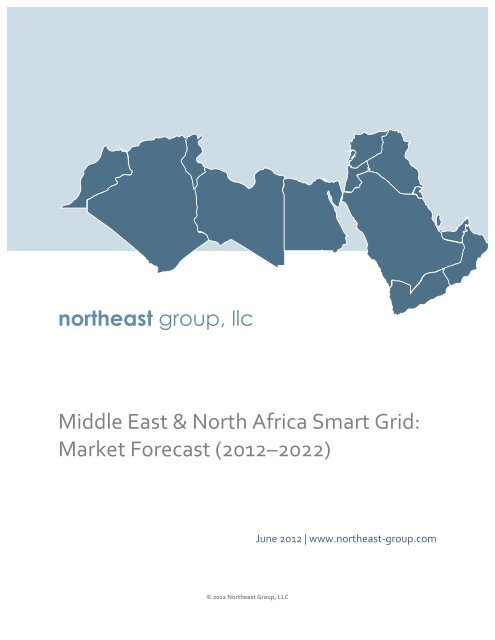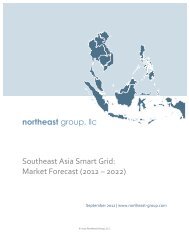Middle East & North Africa Smart Grid: Market Forecast (2012-2022)
Middle East & North Africa Smart Grid: Market Forecast (2012-2022)
Middle East & North Africa Smart Grid: Market Forecast (2012-2022)
- No tags were found...
Create successful ePaper yourself
Turn your PDF publications into a flip-book with our unique Google optimized e-Paper software.
y reducing domestic demand for oil and gas -‐ both through decreased overall demand and through the incorporation of renewable resources -‐ freeing up more oil and natural gas for export. Additionally, instituting some level of dynamic pricing mechanisms to the domestic electricity market will raise additional funds, while reducing technical and non-‐technical losses will ease the cost to the government of electricity subsidies. With volatile oil and gas markets and GDP growth rates expected to temper following the enormous growth of the past several years, Gulf countries will need to look in new directions to ensure the wealth that drives current domestic spending programs. To a certain extent, the same holds true outside of the Gulf. The biggest differences with MENA countries outside of the Gulf are lower electricity consumption profiles and challenging political environments. But even though energy consumption is not nearly as high in other MENA countries, it is growing quickly and will continue to do so as the region’s large youth population reaches working age. Governments throughout the region will therefore face increasing challenges in supplying affordable and reliable power to their populations. In the short-‐term, the political changes seen throughout MENA may stall investment, but in the long-‐term, smart grid will prove instrumental in meeting the goals of modernization and reliable public infrastructure. Key questions answered in this report: • How large will the smart meter market – including 5 segments -‐ in MENA become over the next decade? • Which countries are developing smart grid regulatory frameworks and what do they look like? • Which international vendors are already active in MENA? How will rules on local participation affect international investment in the smart grid market? • Which communications technologies will be favored by utilities in the MENA region? • How will the development of renewable sources of energy affect smart grid in the MENA region? • What pilot projects are in place and what hurdles have they faced? !"#$%"&'()*+,'$)-.()*+/!,0+!"#$%&'$()&)*+*,-."*/%&(/&0123&E4##+1424A)>41+5)%4+1424A)>41+,12.*341+54$4%"*6+7*8%.#$%'3$'%4+/,570+9)'%34:+;)%$
Table of Contents i. Executive Summary 1 ii. Methodology 8 1. Introduction 10 1.1 What is smart grid? 10 1.2 <strong>Smart</strong> grid’s role in regional interconnection 17 1.3 How has smart grid been used elsewhere in the world? 21 2. MENA smart grid snapshot 25 2.1 The region in comparison 26 2.2 Regional drivers 29 2.3 Regional challenges 33 2.4 Most recent developments 35 3. Regional market forecast 37 4. United Arab emirates 41 4.1 Electricity industry structure 41 4.2 <strong>Smart</strong> metering regulatory environment 43 4.3 <strong>Market</strong> forecast 46 4.4 Utility activity 48 5. Saudi Arabia 52 5.1 Electricity industry structure 52 5.2 <strong>Smart</strong> metering regulatory environment 56 5.3 <strong>Market</strong> forecast 58 5.4 Utility activity 60 6. Qatar 62 6.1 Electricity industry structure 62 6.2 <strong>Smart</strong> metering regulatory environment 65 6.3 <strong>Market</strong> forecast 66 6.4 Utility activity 68 7. Oman 70 7.1 Electricity industry structure 70 7.2 <strong>Smart</strong> metering regulatory environment 73 7.3 <strong>Market</strong> forecast 74 7.4 Utility activity 75 8. Kuwait 77 8.1 Electricity industry structure 77 8.2 <strong>Smart</strong> metering regulatory environment 80 8.3 <strong>Market</strong> forecast 80 8.4 Utility activity 81 © <strong>2012</strong> <strong>North</strong>east Group, LLC
Figure 2.1: Emerging markets smart meter potential Figure 2.2: Per-‐capita electricity consumption Figure 2.3: Per-‐capita CO 2 emissions Figure 2.4: GDP growth in MENA and the Gulf Table 2.1: <strong>Smart</strong> grid market drivers and barriers in the Gulf Figure 2.5: Per-‐capita consumption in MENA Figure 2.6: Renewable sources of energy in MENA Figure 2.7: Distribution losses in MENA Figure 2.8: Electricity prices in MENA Figure 3.1: Timeline of smart grid developments in MENA Figure 3.2: AMI forecast by country Table 3.1: AMI forecast data by country Figure 3.3: MENA smart meter penetration rate Figure 3.4: Gulf smart meter penetration rate Figure 3.5: AMI cost breakdown Figure 3.6: AMI forecast by segment Table 3.2: AMI forecast data by segment Figure 4.1: UAE AMI penetration rate Table 4.1: <strong>Smart</strong> grid indicators in the UAE Figure 4.2: Voluntary dynamic pricing in Abu Dhabi Box 4.1 Political risk in the UAE Figure 4.3: UAE AMI forecast Table 4.2: UAE AMI forecast data Box 4.2: Masdar City—a carbon neutral smart city Figure 5.1: Saudi Arabia AMI penetration rate Table 5.1: <strong>Smart</strong> grid indicators in Saudi Arabia Box 5.1: Political risk in Saudi Arabia Figure 5.2: Saudi Arabia AMI forecast Table 5.2: Saudi Arabia AMI forecast data Figure 6.1: Qatar AMI penetration rate Table 6.1: <strong>Smart</strong> grid indicators in Qatar Box 6.1: Political risk in Qatar 26 27 27 28 29 30 31 32 34 37 38 38 39 39 39 40 40 41 42 44 45 47 47 49 52 53 55 59 59 62 63 65 © <strong>2012</strong> <strong>North</strong>east Group, LLC
Figure 6.2: Qatar AMI forecast Table 6.2: Qatar AMI forecast data Box 6.2: The Pearl Qatar project Figure 7.1: Oman AMI penetration rate Table 7.1: <strong>Smart</strong> grid indicators in Oman Box 7.1: Political risk in Oman Figure 7.2: Oman AMI forecast Table 7.2: Oman AMI forecast data Figure 8.1: Kuwait AMI penetration rate Table 8.1: <strong>Smart</strong> grid indicators in Kuwait Box 8.1: Political risk in Kuwait Figure 8.2: Kuwait AMI forecast Table 8.2: Kuwait AMI forecast data Figure 9.1: Bahrain AMI penetration rate Table 9.1: <strong>Smart</strong> grid indicators in Bahrain Box 9.1: Political risk in Bahrain Figure 9.2: Peak demand in Bahrain Figure 9.3: Bahrain AMI forecast Table 9.2: Bahrain AMI forecast data Figure 10.1: Distribution losses in MENA Figure 10.2: Jordan AMI penetration rate Figure 10.3: Jordan AMI forecast Table 10.1: Jordan AMI forecast data Figure 10.4: Egypt AMI penetration rate Figure 10.5: Egypt AMI forecast Table 10.2: Egypt AMI forecast data Table 11.1: Vendors based in the Gulf Figure 11.1: International AMI vendors in MENA Table 12.1: The next steps and necessary actions 67 67 68 70 71 72 74 74 77 78 79 81 81 83 84 85 86 87 87 90 92 93 93 94 95 95 99 103 107 © <strong>2012</strong> <strong>North</strong>east Group, LLC



